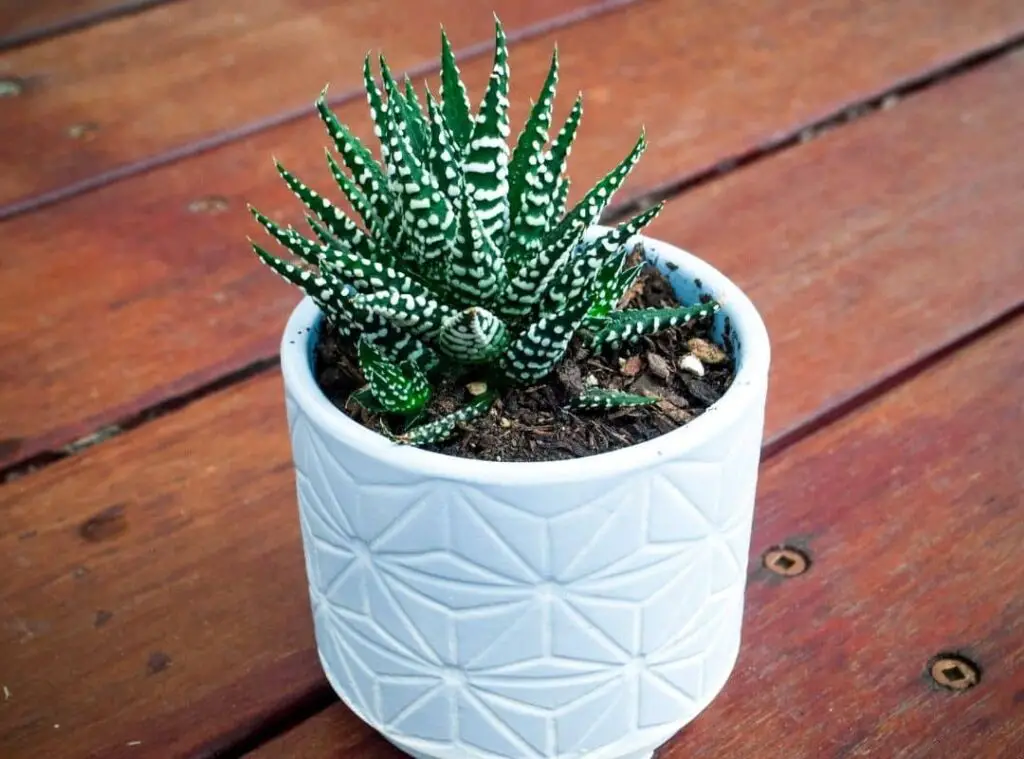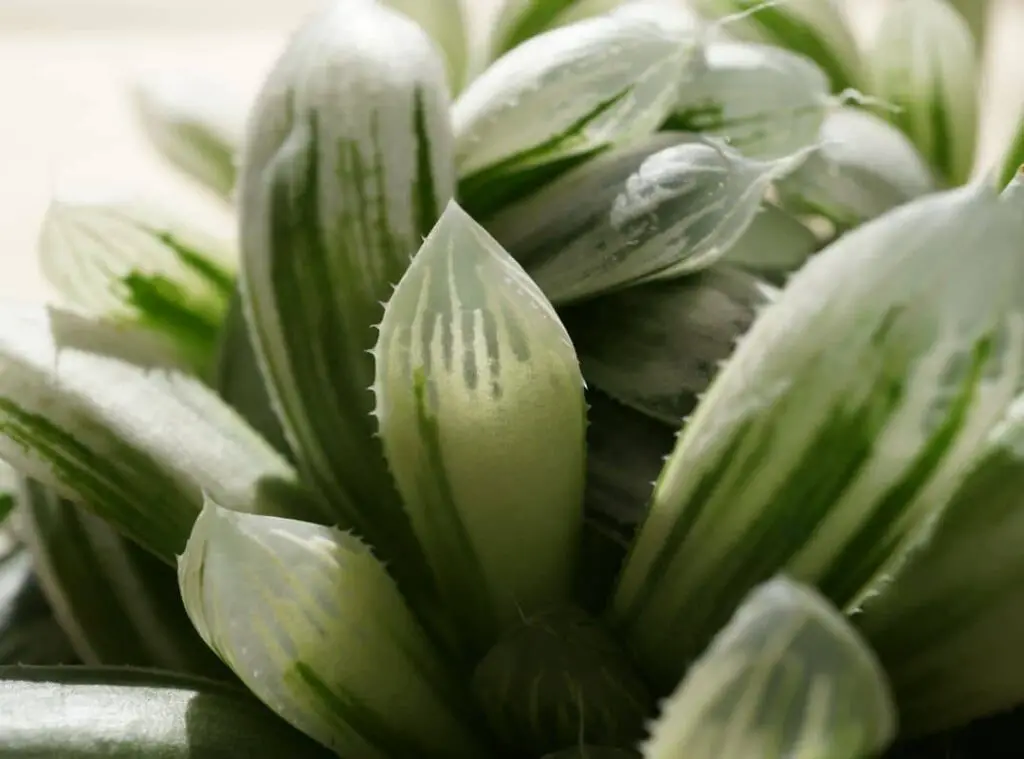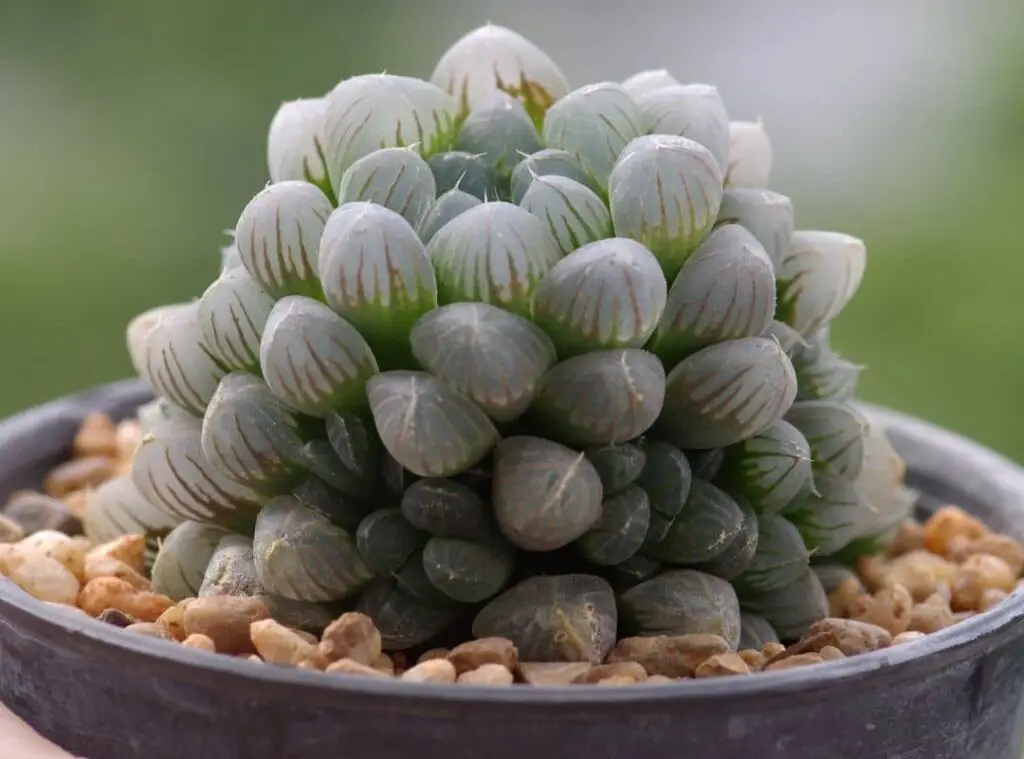Haworthia is a genus of small succulent plants native to South Africa. But Is Haworthia a Good Indoor Plant ? With their attractive foliage and easy care requirements, Haworthias make excellent indoor plants.

Here’s a detailed look at what makes Haworthia such a good choice for indoors.
An Introduction to Haworthia
Haworthias are part of the Aloe family, but they are smaller and have distinctive features that set them apart. There are around 60 species of Haworthia, though some varieties are more popular as houseplants. Some of the most common types found in homes and offices include:
- Haworthia attenuata – Distinctive green leaves with raised white bands, giving them a zebra-like striped appearance.
- Haworthia limifolia – Long, triangular, fleshy leaves that grow in a rosette shape.
- Haworthia fasciata – Dark green leaves with raised white marks in bands or dots. Commonly known as the “zebra plant”.
- Haworthia cooperi – Rounded, plump green leaves with raised translucent dots that allow light to shine through.
- Haworthia retusa – Thick triangle-shaped leaves that end in a blunt point.
The succulent leaves of Haworthia are unique. They grow in a rosette shape, meaning the leaves radiate out from a central point like rose petals. The leaves can be smooth or textured with raised bands, dots, or horny spines. This interesting foliage makes them prized as ornamental plants.
What Makes Haworthia a Great Indoor Plant?
There are many reasons why Haworthia succeeds as a houseplant. Here are some of the main advantages:
Thrives in Low Light Conditions
Haworthias are adapted to shady conditions. In their native habitat in South Africa, most species grow tucked under bushes or in rocky crevices where they are sheltered from intense sunlight.
This makes them perfect for indoor environments where light levels tend to be low. They can thrive in rooms with west or east facing windows. Some varieties can even tolerate artificial fluorescent lighting in offices. Rotate the plants occasionally so all sides get exposure to light.
Tolerates Drought
With their ability to store water in their thick, succulent leaves, Haworthias are very drought tolerant. They don’t need frequent watering and can withstand dry indoor air.
Wait until the soil has fully dried out before watering. The leaves will start to look thin and wrinkled when they need a drink. Overwatering is a much bigger threat than underwatering for these succulents.
Resilient & Easy to Care For
Haworthias are not bothered by pests, diseases, or fluctuations in temperature like many houseplants. Their simple care makes them ideal for beginners or busy indoor gardeners. Just situate them in a spot with some sun and water every couple weeks.
The plants aren’t needy or demanding at all!
Compact Size for Tabletops & Small Spaces
With their relatively small size, Haworthias are perfect for display in terrariums and small planters. They bring greenery to desktops, shelves, and windowsills without needing much surface area. The compact rosettes also work great in mixed succulent arrangements.
Beautiful & Unique Appearance
Of course, a major perk of Haworthias is simply their attractive and intriguing appearance! The surface texture and patterns of ridges, dots, and stripes on the leaves gives them visual appeal. Haworthias add nice contrast and a tropical look to indoor plant displays.

How to Care for Haworthia Plants
Caring for Haworthia houseplants is straightforward, but there are still a few key things to know to help them thrive. Here are some care tips:
Sunlight
While they don’t need full sun, Haworthias do best with 3-6 hours of sunlight per day. East or west facing windows are ideal. Rotate the pots regularly so all sides get sun exposure. Leaves that start to stretch upwards are a sign the plant wants more light.
Soil
Use a well-draining potting mix formulated for cacti and succulents. Or create your own blend of equal parts potting soil, coarse sand, and perlite. The soil needs to dry out in between waterings. Add gravel or pebbles in the bottom of pots to improve drainage.
Watering
During the growing season in spring and summer, water when the soil has fully dried out. Wait until the leaves look thin, wrinkled or curling before watering again. In the dormant winter months, reduce watering even further to just every 2-3 weeks.
Temperature & Humidity
Haworthias like average room temperatures between 65-80°F (18-27°C). Keep away from hot radiators or cold drafts. Low humidity around 30-50% is fine – these succulents don’t require high humidity.
Fertilizer
Use a balanced houseplant fertilizer at 1/4 to 1/2 strength during the growing season. Avoid fertilizing in winter and fall months.
Propagation
Haworthias are easily propagated from offsets. Gently remove the offsets or “pups” from the base of the mother plant. Let them dry for 2-3 days until the cut end forms a callus. Then plant in well-draining soil.
Repotting
Repot in the spring every 2-3 years as needed. Choose a pot only slightly larger than the current roots. Take care not to damage the roots when repotting.
Common Problems with Haworthia
When provided with proper growing conditions, Haworthia is relatively problem-free. But here are a few potential issues to watch for:
- Overwatering – Excess moisture causes root rot. Leaves turn translucent and soft. Allow soil to dry between waterings.
- Underwatering – Leaves shrivel and wrinkle with prolonged drought. Resume regular watering.
- Sunburn – Direct hot sunlight scorches leaves. Move to a shadier spot.
- Pests – Mealybugs and aphids can sometimes infest the leaves. Wipe with alcohol or insecticidal soap.
- Etiolation – Low light causes excessive stretching of leaves. Give more sunlight.
- Root damage – Repotting too vigorously injures delicate roots. Handle roots gently when repotting.
Tips for Displaying Haworthia
- Group Haworthia together with other low light succulents like aloe, echeveria, and gasteria.
- Plant in shallow open containers like bowls and dishes to show off rosette shapes.
- Mix varieties with contrasting textures – smooth and spiky, solid and striped.
- Display in hanging planters, on plant stands, or elevated on coffee tables and shelves.
- Complement the greens and whites with terra cotta pots, blue ceramic, and silver metals.

Common Varieties of Haworthia for Indoors
Now that you know the basics of caring for haworthia plants, let’s take a closer look at some of the most popular varieties well-suited for growing indoors:
Zebra Plant (Haworthia attenuata)
One of the easiest and most distinctive haworthias, the Zebra Plant has dark green leaves decorated with raised white bands resembling zebra stripes. It stays compact at around 4 inches tall and wide. The striped foliage has a nice architectural look.
Star Window Plant (Haworthia limifolia)
True to its name, the Star Window Plant has unique triangle shaped leaves that end in a translucent tip, like a stained glass window. The leaves are arranged in a rosette reaching about 5 inches in diameter. Slow growing and easy care.
Haworthia cooperi
This small haworthia has chunky green leaves covered in oval translucent spots. The lime green light shining through the leaf windows gives it a luminous look. Mature plants grow up to 3 inches tall and wide.
Haworthia retusa
A popular haworthia species, Haworthia retusa has thick, dark green leaves that come to a rounded point. The leaves have a heavily textured surface dotted with small translucent areas. Stays compact under 4 inches tall.
Haworthia fasciata “Zebra Plant”
Probably the most common houseplant type, Haworthia fasciata has the distinctive zebra stripes that give it its nickname. The bumpy leaves have slightly curled tips. Easy to care for and stays small around 3 inches tall.
Unique Uses for Haworthia Plants
Beyond simply being attractive houseplants, there are some more creative and practical ways to incorporate Haworthias in your home:
- Create a living wall display by mounting Haworthia in vertical planters.
- Use the succulents to green up your bathroom space – they tolerate steam and humidity.
- Plant Haworthia in a mirrored tray or bowl for unique tabletop centerpiece.
- Arrange in eclectic containers like seashells, driftwood, or antiques.
- Give away mini Haworthia plants in handmade pots as gifts.
- Use smaller species as desk plants in offices and bedrooms.
- Plant as a living garden for a fairy or miniature scene.
- Add Haworthias to mixed succulent wreaths and vertical gardens.
The Takeaway
With their sculptural shapes, intriguing textures, resilient nature and simple needs, haworthias are the perfect choice for livening up indoor spaces without any hassle. Their diverse sizes and leaf patterns give you plenty of options to play around with in designing plant displays. Haworthias can turn any windowless space into an urban oasis! They provide a touch of nature that instantly uplifts a room.
Read Next:
Haworthia Cooperi Light Requirement | 5 Remarkable Facts |
Haworthia Cooperi Watering | 15 Very Important Facts |
Haworthia Maughanii 14 Care Tips And Propagation Methods
Haworthia Cooperi Flowers | 7 Facts About This Stunning Flower |
